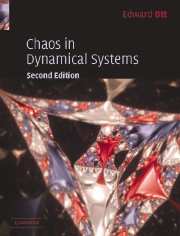Book contents
- Frontmatter
- Contents
- Preface to the first edition
- Preface to the second edition
- 1 Introduction and overview
- 2 One-dimensional maps
- 3 Strange attractors and fractal dimension
- 4 Dynamical properties of chaotic systems
- 5 Nonattracting chaotic sets
- 6 Quasiperiodicity
- 7 Chaos in Hamiltonian systems
- 8 Chaotic transitions
- 9 Multifractals
- 10 Control and synchronization of chaos
- 11 Quantum chaos
- References
- Index
10 - Control and synchronization of chaos
Published online by Cambridge University Press: 05 June 2012
- Frontmatter
- Contents
- Preface to the first edition
- Preface to the second edition
- 1 Introduction and overview
- 2 One-dimensional maps
- 3 Strange attractors and fractal dimension
- 4 Dynamical properties of chaotic systems
- 5 Nonattracting chaotic sets
- 6 Quasiperiodicity
- 7 Chaos in Hamiltonian systems
- 8 Chaotic transitions
- 9 Multifractals
- 10 Control and synchronization of chaos
- 11 Quantum chaos
- References
- Index
Summary
In the preceding chapters we have been mainly concerned with studying the properties of chaotic dynamical systems. In this chapter we adopt a different, more active, point of view. In particular, we ask, can we use our knowledge of chaotic systems to achieve some desired goal? Two general areas where this point of view has proven useful are the control of chaos and the synchronization of chaotic systems. By control we shall generally mean feedback control. That is, we have some control variable that we can vary as a function of time, and we decide how to do this variation on the basis of knowledge (perhaps limited) of the system's past history and/or current state. In the synchronization of chaos, we generally shall be considering two (or more) systems that are coupled. The evolution is chaotic, and we are interested in the conditions such that the component systems execute the same motion. Both control of chaos and synchronization of chaos have potential practical applications, and we shall indicate these as this chapter proceeds.
Control of chaos
Two complementary attributes sometimes used to define chaos are (i) exponentially sensitive dependence and (ii) complex orbit structure. A quantifier for attribute (i) is the largest Lyapunov exponent, while a quantifier for attribute (ii) is the entropy (e.g., the metric entropy or the topological entropy, Section 4.5). These attributes of chaos can be exploited to fashion chaos-control strategies.
Information
- Type
- Chapter
- Information
- Chaos in Dynamical Systems , pp. 379 - 420Publisher: Cambridge University PressPrint publication year: 2002
Accessibility standard: Unknown
Why this information is here
This section outlines the accessibility features of this content - including support for screen readers, full keyboard navigation and high-contrast display options. This may not be relevant for you.Accessibility Information
- 1
- Cited by
